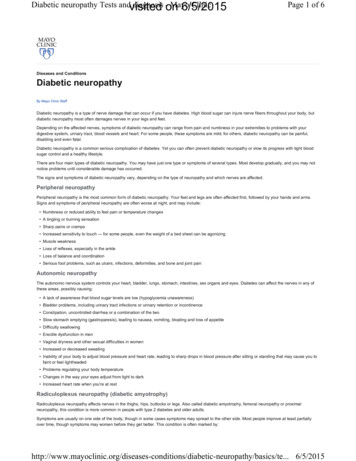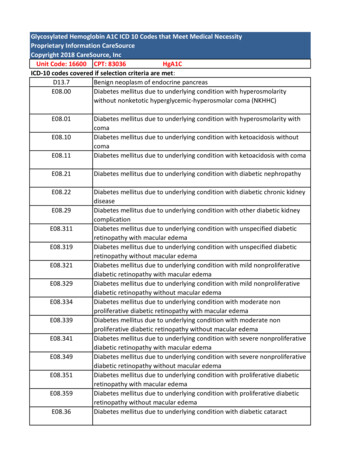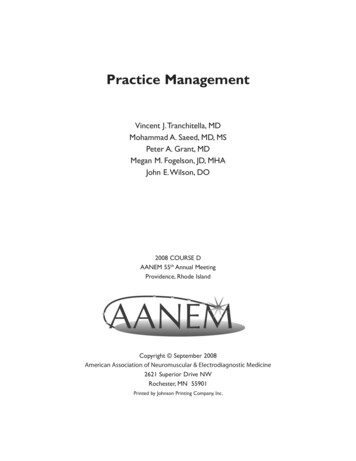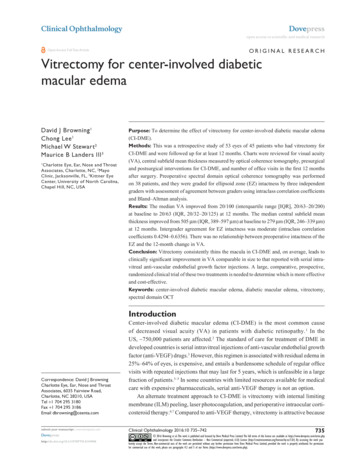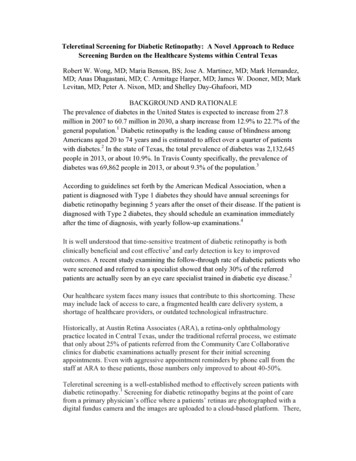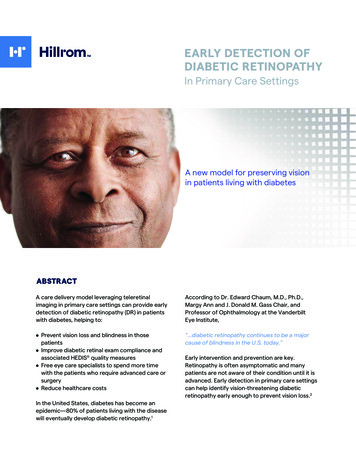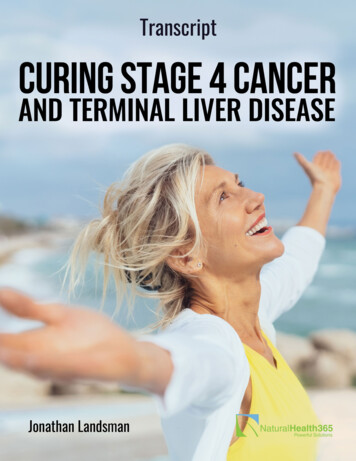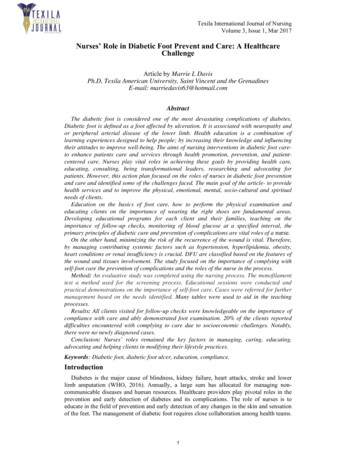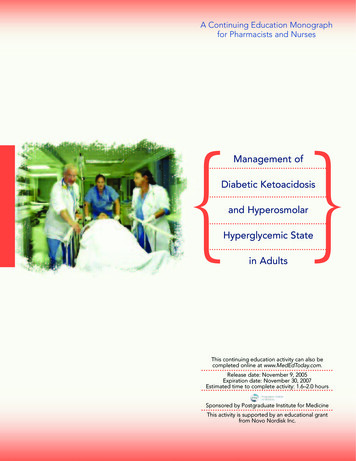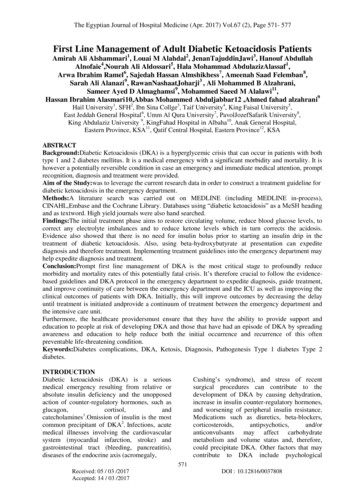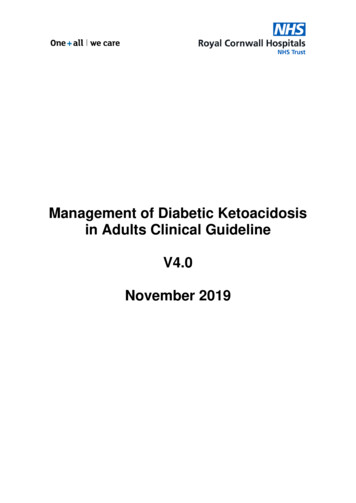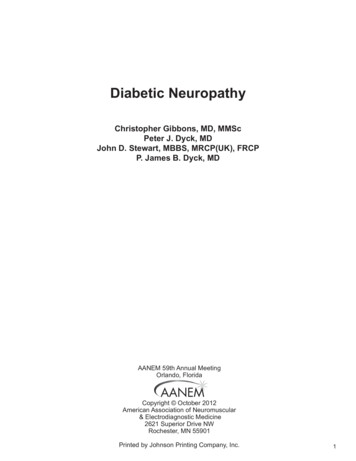
Transcription
Diabetic NeuropathyChristopher Gibbons, MD, MMScPeter J. Dyck, MDJohn D. Stewart, MBBS, MRCP(UK), FRCPP. James B. Dyck, MDAANEM 59th Annual MeetingOrlando, FloridaCopyright October 2012American Association of Neuromuscular& Electrodiagnostic Medicine2621 Superior Drive NWRochester, MN 55901Printed by Johnson Printing Company, Inc.1
Please be aware that some of the medical devices or pharmaceuticals discussed in this handout may not be cleared by the FDA or cleared by the FDA forthe specific use described by the authors and are “off-label” (i.e., a use not described on the product’s label). “Off-label” devices or pharmaceuticals maybe used if, in the judgment of the treating physician, such use is medically indicated to treat a patient’s condition. Information regarding the FDA clearancestatus of a particular device or pharmaceutical may be obtained by reading the product’s package labeling, by contacting a sales representative or legalcounsel of the manufacturer of the device or pharmaceutical, or by contacting the FDA at 1-800-638-2041.2
Diabetic NeuropathyTable of ContentsCourse Committees & Course Objectives4Faculty5Autonomic and Treatment-Induced Diabetic NeuropathyChristopher H. Gibbons, MD, MMSc7Diabetic Polyneuropathies: Classification, Epidemiology, Mechanisms & TreatmentPeter J. Dyck, MD13Mononeuropathies in DiabeticsJohn D. Stewart, MBBS, MRCP(UK), FRCP(C)17Diabetic Inflammatory Neuropathies: The Radiculoplexus Neuropathies of Diabetes MellitusP. James B. Dyck, MD23CME Questions31No one involved in the planning of this CME activity had any relevant financial relationships to disclose.Authors/faculty have nothing to discloseChair: Mark A. Ferrante, MDThe ideas and opinions expressed in this publication are solely those of the specific authorsand do not necessarily represent those of the AANEM.3
ObjectivesObjectives - Participants will acquire skills to (1) discuss the clinical characteristics and risk factors of treatment-induced diabetic neuropathy andreview diabetic autonomic neuropathies, (2) examine whether peripheral neuropathy occurs in association with glucose impairment and review theclinical characteristics and outcomes of diabetic sensorimotor peripheral neuropathy, (3) explain which mononeuropathies occur more frequently indiabetic patients and discuss the clinical features and potential treatments of these mononeuropathies, and (4) examine the diabetic neuropathies that aredue to inflammatory and immune causes, review their clinical and pathological findings, review results of controlled immunotherapy trials in diabeticlumbosacral radiculoplexus neuropathy, and see if an association exists between diabetes mellitus and CIDP.Target Audience: Neurologists, physical medicine and rehabilitation and other physicians interested in neuromuscular and electrodiagnostic medicine Health care professionals involved in the management of patients with neuromuscular diseases Researchers who are actively involved in the neuromuscular and/or electrodiagnostic researchAccreditation Statement - The AANEM is accredited by the Accreditation Council for Continuing Medical Education to provide continuing medicaleducation (CME) for physicians.CME Credit - The AANEM designates this live activity for a maximum of 3.25 AMA PRA Category 1 CreditsTM. If purchased, the AANEM designatesthis enduring material for a maximum of 5.75 AMA PRA Category 1 CreditsTM. This educational event is approved as an Accredited Group LearningActivity under Section 1 of the Framework of Continuing Professional Development (CPD) options for the Maintenance of Certification Program ofthe Royal College of Physicians and Surgeons of Canada. Physicians should claim only the credit commensurate with the extent of their participationin the activity. CME for this course is available 10/2012 - 10/2015.CEUs Credit - The AANEM has designated this live activity for a maximum of 3.25 AANEM CEUs. If purchased, the AANEM designates thisenduring material for a maximum of 5.75 CEUs.2011-2012 Course CommitteeShawn J. Bird, MD, ChairPhiladelphia, PAShashi B. Kumar, MDTacoma, WAMarcy C. Schlinger, DOBath, MILawrence W. Frank, MDElmhurst, ILA. Arturo Leis, MDJackson, MSNizar Souayah, MDWestfield, NJTaylor B. Harrison, MDAtlanta, GABenjamin S. Warfel, II, MDLancaster, PA2011-2012 AANEM PresidentJohn C. Kincaid, MDIndianapolis, IN
Diabetic NeuropathyFacultyChristopher Gibbons, MD, MMScDr. John D. Stewart BSc., MBBS, MRCP(UK), FRCPCDr. Gibbons is an Assistant Professor of Neurology at HarvardMedical School. He is on staff at Beth Israel Deaconess MedicalCenter and Joslin Diabetes Center in Boston, Massachusetts.Dr. Gibbons is the director of the Joslin Diabetes Center’sNeuropathy Clinic and directs the Neurocutaneous Skin BiopsyProgram at Beth Israel Deaconess. He is the Chair-elect for theAutonomic Section of the American Academy of Neurology andon the Board of Directors of the American Autonomic Society.Dr. Gibbons is engaged in clinical research in diabetic peripheraland autonomic neuropathies. He holds a K23 research grant withthe NIH (NINDS). His research includes the investigation ofsensory and autonomic neuropathy in diabetes, with a focus ontreatment induced diabetic neuropathy.Dr. Stewart graduated with a medical degree from the University of the West Indies and did postgraduate studies in InternalMedicine and Neurology in the United Kingdom. He then workedat the University of Nairobi, Kenya, before moving to Canadafor further neurology training at McGill University. He spentthe next 25 years at McGill developing his special interests inperipheral neuropathies and disorders of the autonomic nervoussystem. Dr. Stewart is Emeritus Professor, McGill University, andClinical Assistant Professor, University of British Columbia. Healso works as a community neurologist in North Vancouver, associated with Lions Gate Hospital. Dr. Stewart is the author ofFocal Peripheral Neuropathies.Peter James Dyck, MDDepartment of NeurologyMayo ClinicRochester, MinnesotaDepartment of NeurologyBeth Israel Deaconess Medical CenterBoston, MADepartment of NeurologyMayo Clinic and Mayo Medical SchoolRochester, MNDr. Dyck is the Roy E. and Merle Meyer Professor ofNeuroscience, Professor and Consultant in Neurology, at MayoMedical School and Mayo Clinic. He heads Mayo’s PeripheralNeuropathy Research Laboratory. Dr. Dyck’s clinical practice andresearch interests have encompassed most varieties of peripheralneuropathy. He is completing large-scale epidemiology surveys ofhealthy subjects and patients with diabetes of Caucasian, Hispanic,and Northern Plains Indians origin and recently completed studieson the occurrence of diabetic polyneuropathy in patients withimpaired glycemia in Olmsted County, Minnesota. Dr. Dyck’smedical degree was earned at the University of Toronto andcompleted Neurology fellowships at both Mayo and UniversityHospital-Saskatchewan. Dr. Dyck has been the first editor of12 volumes of textbooks on various aspects of peripheral nervebiology and its diseases. He received Honorary Membership inthe AANEM in 2001.Division of NeurologyLions Gate Hospital & University of British ColumbiaNorth Vancouver, British Columbia, CanadaP. James. B. Dyck, MDDr. Dyck received his medical degree from the University of Minnesota School of Medicine and completed an internship at Virginia Mason Hospital in Seattle, a residency at Barnes Hospital andWashington University in Saint Louis, Missouri, and a fellowshipin peripheral nerve and electromyography at the Mayo Clinic inRochester. He is an Associate Professor of Neurology at the MayoClinic. Dr. Dyck is a member of several professional societies,including the AANEM, the American Academy of Neurology, thePeripheral Nerve Society, and the American Neurological Association. His current research interests include pathological studies of peripheral nerve disorders and clinical trials in peripheralneuropathies.5
6
DIABETIC NEUROPATHIESAutonomic and Treatment-InducedDiabetic NeuropathyChristopher H. Gibbons, MD, MMScAssistant Professor of Neurology, Harvard Medical SchoolDirector, Joslin Diabetes Center Neuropathy ClinicStaff Neurologist, Beth Israel Deaconess Medical CenterBoston, MassachusettsPREVALENCE OF DIABETIC AUTONOMICNEUROPATHYMANIFESTATIONS OF DIABETIC AUTONOMICNEUROPATHYSymptoms of autonomic dysfunction secondary to diabetes havebeen reported in detail over the past century. However, the relativefrequency of autonomic dysfunction reported in diabetes hasbeen difficult to establish in individuals or populations becauseof the variable involvement of the different organ systems. Asan example, some degree of erectile dysfunction is seen in morethan 50% of males with diabetes while cardiovascular autonomicneuropathy is seen in 15-30%, but this depends on the populationstudied, the type of test used for diagnosis, and the duration ofdiabetes. If all tests of autonomic function are considered in thediagnosis of diabetic autonomic neuropathy, prevalence rates ashigh as 90% have been reported.1-4 Therefore, understanding thefrequency of autonomic neuropathy in a given population requiresa description of the type of end organ function measured and thespecific methodology used to define an abnormal result.PupillaryThere is an association between sensory neuropathy and autonomicneuropathy that is also variably reported depending on themethods of evaluation. Thus, if autonomic neuropathy is definedby orthostatic hypotension and presence of sensory neuropathyis defined by abnormal nerve conduction studies the relativefrequency of abnormality may be lower than 5%. However, if skinbiopsy measurements of nerve fiber density are defined for smallfiber neuropathy and cardiovagal abnormalities are used to defineautonomic neuropathy, rates higher than 30% may be expected in ageneral population of patients with diabetes. Although autonomicneuropathy is frequently seen in patients with a distal lengthdependent sensory or sensorimotor neuropathy some patients maypresent with autonomic neuropathy in isolation.4Sympathetic innervation of the iris shows earlier and moreextensive dysfunction than parasympathetic innervation, resultingin an inability to rapidly or completely dilate the pupil in darkness.Patients often describe difficulty seeing and driving at night. Thisfinding may be seen at the time of diabetes diagnosis and is relatedto glycemic control.5,6GastrointestinalGastroparesis is one of the more common, and most feared,complications of diabetes. Seen in 30-50% of individualswith longstanding diabetes, it results in early satiety, nausea,vomiting, inconsistent medication absorption, and weight loss,and it is often described in association with “brittle diabetes.”7-9Gastric emptying is measured through use of scintigraphy oftechnetium labeled egg whites 4 hours after eating. In addition todelayed gastric emptying, esophageal dysmotility is commonlyseen in diabetes (approximately 50% of individuals with diabetes 10 years) and may mimic cardiac pain in some patients. Lowergastrointestinal dysfunction in diabetes may present as eitherconstipation or diarrhea. The constipation is typically not assevere as other autonomic failure syndromes. However, diabeticdiarrhea can be disabling, with frequent bowel movements thatare often nocturnal, resulting in dehydration, sleep disruption, andsignificant anxiety.87
AUTONOMIC AND TREATMENT-INDUCED DIABETIC NEUROPATHYGenitourinaryErectile dysfunction is the most prominent manifestation ofdiabetic autonomic neuropathy in males, and it may manifestas decreased tumescence, rigidity and rarely retrogradeejaculation.8,10 In women, dyspareunia may be the presentingsymptom of diabetic autonomic neuropathy due to dry, atrophicvaginal walls.8,10 Bladder dysfunction can present in both gendersas a consequence of autonomic neuropathy. Efferent autonomicbladder dysfunction may present with decreased voiding sensationand decreased frequency which may increase risks of urinary tractinfections (UTIs). Afferent autonomic neuropathy often occursafter longer diabetes duration and results in increasing post-voidresiduals and increased UTIs.11SudomotorSweating abnormalities are common in diabetes and may be themost prevalent manifestation of a distal neuropathy.12 In earlycases of neuropathy, distal hyperhidrosis may occur transientlywhich eventually develops into a length-dependent anhidrosis.13The development of dry, cracked skin can increase the risk forskin breakdown and is a portal to infection. As the region ofanhidrosis grows larger, central hyperhidrosis occurs to maintainthermoregulatory capacity. However, the primary complaint bypatients is often increased central and facial perspiration.14CardiovascularOne of the initial findings of a cardiovascular autonomicneuropathy in diabetes is a resting tachycardia.4,15 Associatedsymptoms include exercise intolerance and orthostatic intolerance.There is some evidence that cardiovascular autonomic neuropathymay also result in impaired left ventricular function in individualswithout underlying cardiac disease.4,16-19 In addition, there is anassociation between cardiovascular autonomic neuropathy andpainless myocardial ischemia. As autonomic neuropathy worsens,orthostatic hypotension (defined as a sustained fall in systolicblood pressure 20 mgHg or fall in diastolic blood pressure 10mmHg within 3 minutes of standing) is more prevalent and moresevere.8,19,20Hypoglycemic UnawarenessHypoglycemic unawareness is also referred to as an autonomicneuropathy of the adrenal medulla or hypoglycemia associatedautonomic failure.21 Hypoglycemia is a complex physiologicstress that activates the hypothalamic-pituitary axis and thesympatho-adrenal system.22 Hypoglycemia results in increasedcirculating glucocorticoids and catecholamines, but also resultsin blunted counter-regulatory autonomic responses to subsequenthypoglycemia thus reducing the defense against falling bloodglucose and creating a vicious cycle of repeated episodes ofhypoglycemia in insulin-treated diabetes.21NATURAL HISTORY OF DIABETICAUTONOMIC NEUROPATHYNatural history studies traditionally have investigated theinvolvement of a single organ system in diabetes, such as8cardiovascular autonomic neuropathy, thus true rates of diseaseprogression are relatively unknown. In patients with newlydiagnosed type 2 diabetes, a 10-year natural history study basedin Kuopio, Finland, investigated the rates of cardiac autonomicneuropathy progression using a combination of orthostatic bloodpressure tests, Valsalva maneuvers, and heart rate response to deepbreathing. The rate of parasympathetic dysfunction increased from5% to 65% over 10 years in individuals with diabetes, comparedto control subjects who increased from 2% to 28%.23 Sympatheticdysfunction in individuals with diabetes increased from 7% to24% compared to control subjects who increased from 6% to9%.23 In subjects with type 1 diabetes, data have been gleaned fromthe Epidemiology of Diabetes Interventions and Complications(EDIC) and Diabetes Control and Complications Trial (DCCT)trials where heart rate variability, Valsalva maneuvers, and posturalblood pressures were repeated 13-14 years after enrollment inthe DCCT trial. Cardiovascular autonomic neuropathy (definedas abnormal results of any autonomic test) increased from 3-5%at baseline to 29-35% (intensive versus conventional treatments,accordingly).24 Disease progression in type 1 and type 2 diabeteshas been linked to glycemic control, age, duration of diabetes,hypertension, and hyperlipidemia.1,4,24-26 Similarly detailed studieson autonomic dysfunction in the gastrointestinal, genitourinary,respiratory, sudomotor, or pupillary systems have not beenconducted.TESTS OF AUTONOMIC FUNCTION INDIABETESDiagnosis of autonomic neuropathy in diabetes can beaccomplished through relatively simple bedside measurements inthe most advanced cases, but typically requires detailed autonomictesting in the majority of patients. Specific tests commonlyperformed by neuromuscular specialists are reviewed below, butadditional tests of autonomic function can be performed suchas urodynamic studies, gastrointestinal transit studies, anorectalmanometry, and pupillometry.Tests of Cardiovascular Autonomic PhysiologyTests of cardiovascular function measure both the sympatheticand parasympathetic divisions of the autonomic nervous systemsimultaneously. Standard tests of parasympathetic functioninclude the heart rate response to deep breathing, a Valsalvamaneuver, and standing. Standard tests of sympathetic adrenergicfunction include the blood pressure response to a Valsalvamaneuver, standing or tilt table testing.Heart Rate Response to RespirationThe heart rate response to deep, paced breathing provides a simpleand effective measurement of the cardiovagal parasympatheticnervous system. Respiration produces a sinus arrhythmia that ismediated by the vagus nerve. The amplitude of the variation inheart rate is a quantitative measure of parasympathetic health,with reduced variance seen with increasing age and diseaseseverity, but with a number of known confounding factors suchas medication use. Testing is performed with the patient in therecumbent position. Ideally, respiratory bands surrounding theabdomen and chest should be used to provide a noninvasive record
DIABETIC NEUROPATHIESof adequate respiratory effort. Continuous electrocardiogrammonitoring is used to evaluate heart rate response. The patient isasked to take deep inspirations lasting 5 s, followed by expirationlasting 5 s. A total of 6-8 breathing cycles are recorded and thefive largest consecutive cycles are measured, averaged, and theheart rate range (maximum-minimum) is determined. In diabeticautonomic neuropathy, decreased heart rate variability is seencompared to age- and gender-matched healthy subjects.Heart Rate and Blood Pressure Response to aValsalva ManeuverThe Valsalva maneuver is performed by blowing into a tubeagainst 40 mmHg of resistance for approximately 15 s. TheValsalva maneuver is separated into four distinct phases. PhaseI begins with the onset of straining with a transient increase inblood pressure secondary to increased intrathoracic pressure andmechanical compression of the great vessels. Phase II is separatedinto two parts: early and late. In early phase II, decreased venousreturn secondary to mechanical compression of the great vesselsresults in decreased stroke volume, cardiac output, and bloodpressure. After a few seconds late phase 2 begins: the fallingblood pressure is sensed by the carotid baroreceptors resulting insympathetically-mediated vasoconstriction and parasympatheticwithdrawal leading to increased peripheral vascular resistanceand an increase in cardiac output due to increased heart rate.Phase III occurs when subjects stop exhaling against resistance.Blood pressure transiently decreases due to increased capacitanceof the great vessels. Phase IV occurs as the heart rate decreasesand the blood pressure returns to normal or above, deemed the“overshoot.” The blood pressure overshoot is a consequence ofincreasing venous return, stroke volume, and cardiac output intoa vasoconstricted circulation. The heart rate and beat-to-beatblood pressure responses to the Valsalva maneuver are requiredfor interpretation of the results. In diabetic autonomic neuropathy,decreased heart rate variability is seen compared to age- andgender-matched healthy subjects with a greater fall in phase IIblood pressure and diminished phase IV blood pressure overshoot.Heart Rate and Blood Pressure Response toStanding and Tilt TestingThe initial response to standing involves a shift in blood volumeof 300-800 mL from the central to the peripheral vascular systemleading to an abrupt increase in the heart rate mediated byinhibition of vagal tone. There is a gradual increase in heart ratefor another 12 s that is most likely a baroreflex mediated responseto a fall in blood pressure due to release of vasoconstrictortone. A new baseline heart rate is reached within 30 s, and theratio of tachycardia at 15 s to bradycardia at 30 s is a measureof parasympathetic function. The 30:15 ratio is not usuallymeasured during tilt testing because the table transition to anupright position is typically too slow to provoke a full heart rateresponse. The blood pressure response to both upright tilt andstand is monitored, and orthostatic hypotension can be detectedin individuals with diabetic autonomic neuropathy. Prolonged tilttable testing can detect delayed orthostatic hypotension in someindividuals, where blood pressure falls may occur after prolongedperiods of standing.27Tests of Sudomotor PhysiologyThermoregulatory sweating is unique to humans and primatesand is mediated through eccrine sweat glands. Sweatingis a sympathetically-mediated response derived from thehypothalamus through preganglionic cholinergic neuronsthat synapse in the paravertebral ganglia with postganglionicsympathetic cholinergic sudomotor axons. Tests of sudomotorfunction aid in localizing and monitoring disease progressionin diabetic autonomic neuropathy. Traditional neurophysiologicmeasurements of sudomotor function include thermoregulatorysweat testing (TST), quantitative sudomotor axon reflex testing,silicone impressions and sympathetic skin response (SSR),and the recent addition of quantitative direct and indirect axonreflex testing.28,29 TST stimulates sweating by raising the corebody temperature and using an indicator dye to identify regionsof anhidrosis, thus measuring both pre- and postganglionicsudomotor function. The SSR measures electrodermal activityand provides a surrogate measure of sympathetic cholinergicsudomotor function but does not actually measure sweat outputand has a very high degree of variability, thereby limiting itsclinical utility. All other tests of sudomotor function measure thepostganglionic sudomotor axon reflex by measuring sweat outputafter iontophoresis of a cholinergic agent (such as acetylcholine).In diabetes, a distal loss of sudomotor function is commonly seenin patients with a length-dependent neuropathy, and it may be theearliest method to detect a distal small fiber neuropathy.12IMPLICATIONS OF AUTONOMIC NEUROPATHYIN DIABETESPupillaryIndividuals with pupillary dysfunction may be relativelyasymptomatic, but they can have impaired night vision andneed to be aware that nocturnal driving may become unsafe. Inaddition, evidence of pupillary autonomic dysfunction has beenassociated with increased microalbuminuria and retinopathy 12years later, suggesting an increased risk of general microvasculardisease in these individuals.6GastrointestinalThe implications for autonomic neuropathy of the gastrointestinaltract are frequently subclinical, but when more pronounced canhave a major impact on medical management of disease andlifestyle. Delayed esophageal transit can result in heart burn,dysphagia, and chest pain. Delayed gastric emptying is associatedwith nausea, vomiting, and weight loss. As gastroparesis worsens,food and medication absorption are delayed thereby worseningglucose control. Patients on insulin are at risk for hypoglycemiabecause of difficulty regulating the timing of injections. There arealso inconsistent medication responses due to variable absorptionwhich may have profound changes on treatment efficacyand compliance. When gastroparesis is more severe, urgenthospitalization may be required for intractable vomiting andelectrolyte disturbances. In the small and large bowels, bacterialovergrowth and diarrhea may result in pain, diarrhea, and pseudoobstruction.9
AUTONOMIC AND TREATMENT-INDUCED DIABETIC NEUROPATHYGenitourinaryThe medical consequences of genitourinary dysfunction primaryconcern the increased risks of UTI in the setting of incompletebladder emptying. Individuals with diabetes experience bothmore frequent and more severe UTIs than nondiabetic patientsand are predisposed to more complex complications such aspyelonephritis. However, the sexual dysfunction experienced byboth genders is even more common, can have a major impact onquality of life, and is an increasingly frequent topic of discussionat clinical visits.1SudomotorDistal sudomotor dysfunction can lead to dry, cracked skin anda portal to infection in at-risk patients. Aggressive applicationof topical moisturizers is the only effective way to reduce theassociated cutaneous complications in dry environments. Morediffuse anhidrosis can result in proximal hyperhidrosis and maybecome a source of social embarrassment. In patients with morewidespread anhidrosis, the ability to thermoregulate in warmenvironments can become compromised and limit ability toperform certain occupations and may restrict activities of dailyliving, resulting in relocation to cooler climates in extreme cases.CardiovascularCardiovascular autonomic neuropathy can manifest as exerciseintolerance in patients with diabetes. The reduced heart rate andblood pressure response to exercise can limit cardiac output andplace patients and risk if they seek to exercise using their heartrate as a guideline. Patients at risk for cardiovascular autonomicneuropathy should have an exercise stress test prior to participatingin an exercise program.4 Diabetic patients with cardiac autonomicneuropathy have two to three times higher levels of morbidity andmortality during perioperative periods than nondiabetic patients.Both the surgeon and anesthesiologist need to be aware of thepatient’s autonomic neuropathy status prior to anesthesia becauseof risks of arrhythmias and exaggerated blood pressure swingsduring surgery.Orthostatic hypotension, although infrequently severe, may beassociated with supine hypertension. Orthostatic hypotension mayrequire specialized management to raise diurnal blood pressures(to avoid syncope and injury) while avoiding nocturnal supinehypertension and increased risks of renal dysfunction.Overall, patients with diabetic cardiovascular autonomicneuropathy have an increased mortality risk of two to three timesthat of diabetic individuals without cardiovascular autonomicneuropathy. The risk increases with the severity of the autonomicneuropathy.4Hypoglycemic UnawarenessPatients that experience hypoglycemia have an attenuatedcatecholamine and glucocorticoid response to falling bloodglucose. This, in turn, results in a greater risk of additional, andmore profound, hypoglycemia in the future. Overall, patientswith hypoglycemic unawareness have a greater than 25 fold10increased risk of severe hypoglycemia than patients with an intactcatecholamine and glucocorticoid response. Intentional relaxationof glycemic control is often required in these cases, although thereare a number of barriers to compliance because of psychologicalreliance on glycemic control to prevent disease progressionamong individuals with longstanding diabetes.TREATMENT-INDUCED DIABETIC NEUROPATHYTreatment-induced diabetic neuropathy is a rare painful neuropathyassociated with rapid changes in glycemic control. It was firstreported by Caravati in 1933 when he encountered a diabeticwomen that developed numbness, tingling, and shooting pains inthe lower extremities that appeared 4 weeks after the initiation ofinsulin treatment.30 The disorder has also been described as diabeticneuropathic cachexia and acute painful diabetic neuropathy.31-33The neuropathy appears to be more common in individuals withtype 1 diabetes, but is also seen in those with type 2 diabetes.Treatment-induced neuropathy is associated with rapid glycemiccontrol using insulin, oral hypoglycemic medications, and, in rarecases, by severe dietary restriction.31,32,34-36 In the author’s cohortof patients, many individuals had glycosylated hemoglobin A1Cscores in the 12-20% range for many years until they elected tovoluntarily control their glucose. The A1C typically fell to the6-9% range within 3 months or less. Symptoms of neuropathicpain usually began within a few weeks of the improved glucosecontrol as shown in the Figure.The most common clinical presentation includes severe burningand shooting pains in a length-dependent or generalized patternwithin weeks of the onset of glucose control. The pain reflects thecharacteristic diurnal variation of neuropathy, but is still severethroughout the day. The pain is usually continuous and oftenaccompanied by allodynia and hyperalgesia. The reported painis typically more severe and more refractory to treatment thattypical cases of painful diabetic neuropathy. Most patients requirea number of different pharmacologic agents simultaneously forpain control, including narcotics, and still report inadequate relief.The neuropathic pain may gradually begin to spontaneouslyimprove 12-24 months after the onset of glycemic control.On neurologic examination, there is often a loss of thermal andpain sensation while large fiber modalities, motor function, anddeep tendon reflexes are relatively unaffected. Nerve conductionstudies are typically normal in these individuals. Structuralexamination of small nociceptive C fibers by skin biopsy showsdistal or diffuse loss of unmyelinated intraepidermal nerve fiberswith numerous morphologic changes noted within a few weeksof the onset of neuropathic pain. The distribution of pain roughlycorrelates with the regions of intraepidermal nerve fiber density(IENFD) loss. Neurologic examination findings may begin toimprove slightly in some individuals 18-24 months after theonset of glycemic control. On skin biopsy, there may also be anassociated increase in IENFD approximately 12-24 months afterthe onset of glycemic control.Although autonomic symptoms are present in the majority ofindividuals with treatment-induced neuropathy, they are oftenovershadowed by the neuropathic pain and frequently notreported unless they interfere with activities of daily living.
DIABETIC NEUROPATHIESTypical symptoms include postural dizziness and lightheadedness,nause
Neuropathy Clinic and directs the Neurocutaneous Skin Biopsy Program at Beth Israel Deaconess. He is the Chair-elect for the Autonomic Section of the American Academy of Neurology and on the Board of Directors of the American Autonomic Society. Dr. Gibbons is engaged in clinical research in diabetic peripheral and autonomic neuropathies.
